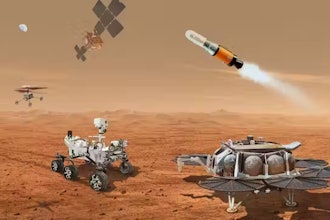An ExoMars launch later this year will send an orbiter and an entry, descent and landing demonstrator module (EDM) to the Red Planet to test atmospheric conditions and mission technology. If all goes well, these instruments will set the stage for a rover mission in 2018.
The ExoMars program — which is a partnership between European and Russian space agencies — will launch the orbiter and EDM on a proton rocket in March. Those instruments will travel for seven months, reaching Mars by October.
The EDM, named the Schiaparelli, will be equipped with sensors to test ExoMars’ landing capabilities. Nine thrusters will help the vessel to land relatively gently, but fueling the hydrazine-powered thrusters and pressurizing the tanks is extremely dangerous.
A special team from Thales Alenia France traveled to the Baikonur Cosmodrome in Russia to handle the hazardous multi-day process.
After Schiaparelli was moved to the fueling area, the team completed various safety checks and filled a high-pressure tank aboard the craft with helium, which pushes the hydrazine through fuel lines to combustion chambers. Between the vessel’s three tanks, the Schiaparelli is carrying about 100 pounds of the toxic fuel.
After landing, the Schiaparelli will deliver a science package to monitor surface conditions for roughly two to four Martian days.
The orbiter will study gases in the Martian atmosphere and eventually relay data from the ExoMars rover mission.






















